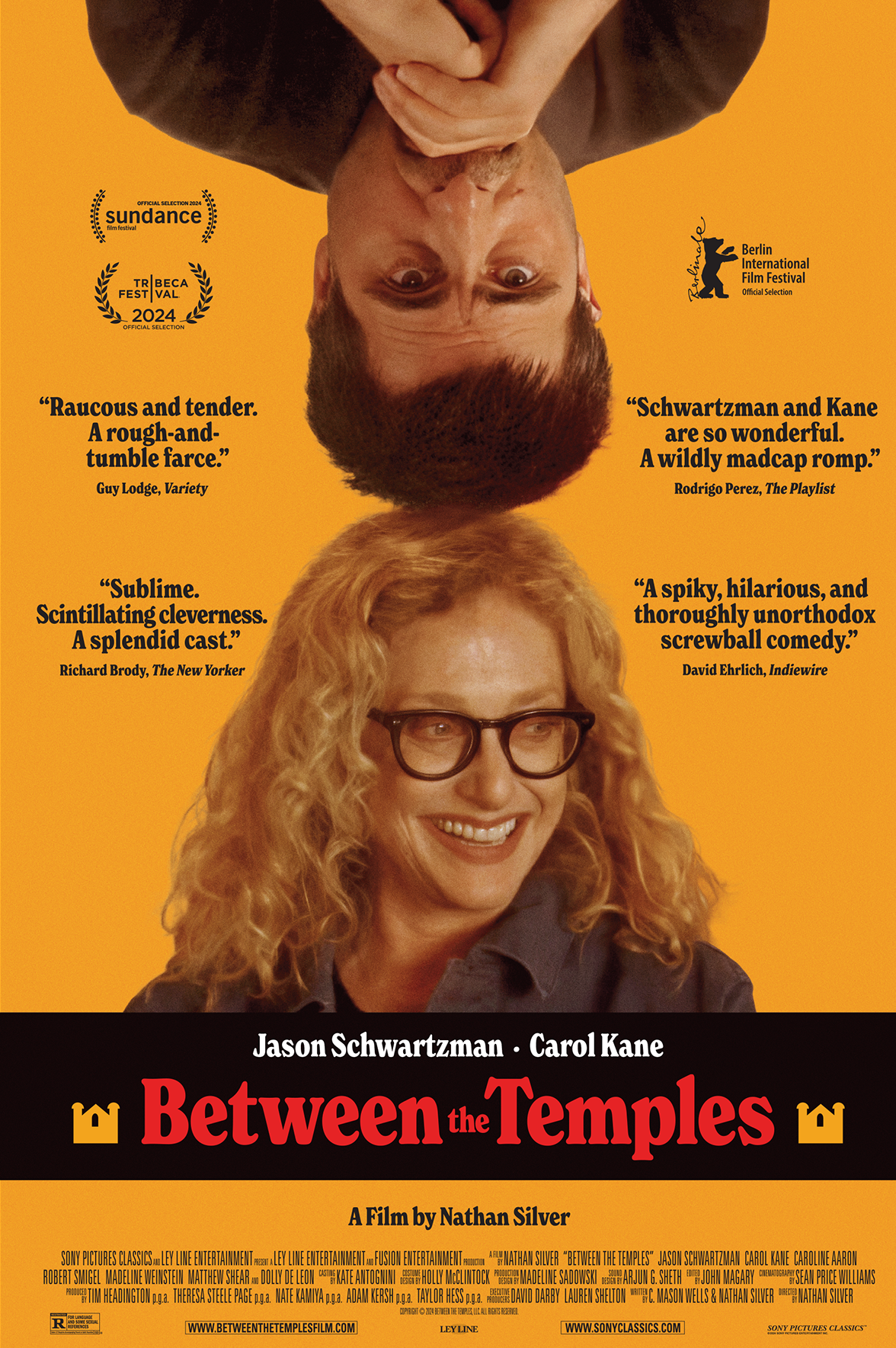American Jewish temple life has inhabited a small niche in the cultural landscape. Lately, that niche has expanded. Recent entries include Kathryn Hahn’s rabbi/love interest character in the series Transparent, the recent Netflix romantic comedy, Nobody Wants This, with Adam Brody as a dreamy, Los Angeles rabbi/love interest, and Jason Schwartzman as a lost, small town New York cantor in Between the Temples. These shows and films are depicting and, in some ways, documenting the experience of American Jews.
We were struck by Between the Temples’ capturing of a particular northeast American Jewish experience, and the way Schwartzman’s character— a cantor grieving the death of his wife, unable to sing, unable to date all the eligible women his two mothers send his way—makes the pathos, humor, and intensity of the Jewish experience come to life. Oh and comedian Robert Smigel plays his Rabbi boss while Carol Kaine plays a late-in-life bat mitzvah student who forms a meaningful and much needed connection with the down and out cantor.
Directed by independent filmmaker Nathan Silver, whose reputation is more burnished on the festival circuit than at the box office (not for long, we hope), Between the Temples conjures its characters and environments with a documentary-like commitment to the real. So much so we felt we needed to speak with Silver to learn more about this film, his background, and whether or not he sees it as a kind of document of American Jewish communities. He was kind enough to speak with us over Zoom earlier this month.
The film felt like an ethnography—like it was both inside and outside the Jewish experience at the same time. Where is your experience in all of this? Where did the idea for this film come from?
Well, I grew up in a secular household. I mean, both my parents are New York Jewish—my father, he got bar mitzvahed. My mother was a red diaper baby. She grew up with socialist parents, so did not ever go to temple. But my grandfather on my mom’s side would always speak Yiddish and my grandmother would yell at him when he would do so. But then later in her life, she started understanding everything he would say, even though she claims to never have learned Yiddish.

Judaism was certainly around the family. We celebrated Passover and Hanukkah. My parents attempted to have me go to a temple or go to Hebrew school, but I was missing the cartoons. So they allowed me to stay home. We lived in Arlington, Massachusetts, which is a very Irish Catholic town. I was the only Jew in my school, and we clung to the New Yorker Jew within us. And all the comedy. Judaism, to me, was comedy and absurdity and laughter. And this idea of a world that wasn’t the one that I was surrounded by in school.
We would go to New York quite often—like once a month—to visit my extended family. Lots of it was like the shabbat scene in my movie, even though we didn’t do shabbat meals, but it felt like this, you know—people laughing, crying. My grandfather pounding the table and saying, “If you have your health, God damn it, you have everything.” Just real, chaotic, beautiful, energy, which has really instructed how I make movies.
So going into this one, which dealt with the rituals and tradition of Judaism, I had to do a lot of research. At first we worked with a rabbi, and then we brought on a Jewish consultant who is a co producer. He comes from a lineage of rabbis and he tutors kids for their bar and bat mitzvahs when he’s not producing. So that was a coup. My co writer Chris [Wells]—who is a goy—he and I would be asking Jesse [Miller], our Jewish consultant, like 25 or 50 questions a day. And Jesse would have answers. And a lot of the questions would be like, well, it depends on the rabbi, depends on the temple, it depends on this, that and the other thing. I think the Northeastern Jewish aspect of it, the yelling, the Ashkenazi, the Woody Allen or the Seinfeld, Larry David kind of thing you have in my family. Except in Between the Temples, it was then applied to someone who actually works within the institution of a synagogue.
There were these really intense close ups on people’s faces, especially in the temple scenes. I felt both seen as a Jew, but also outside looking in.
People have asked me why so much of the movie is shot in close up. Because that’s how being in my family feels. It’s like they’re on top of you and there’s an intrusiveness. And so we wanted the camera to have that sense of intrusion. In Ben’s [the Cantor played by Schwartzman] life there’s constant intrusion. He has a bedroom door that won’t shut. I mean, it’s the metaphor of his life. He has no privacy. And it’s so funny when people ask, why would there be anxiety around this love story? I say, he’s a neurotic Jew struggling in this situation. So those close ups seemed essential.
And then we started thinking, half jokingly, like with The Passion of Joan of Arc, the Dryer movie with all the close ups of the faces. We wanted the temple scene to get close up to the faces. It should feel like what Dreyer did for Catholicism. We do for Judaism.
Judaism, to me, was comedy and absurdity and laughter. And this idea of a world that wasn’t the one that I was surrounded by in school.
Richard Brody, writing in the New Yorker review of the film, suggests that because it was filmed before October 7, it becomes a document of American Jewish or Northeastern American Jewish life before the crisis hit. I’m wondering, can narrative film be a document of a place and culture? Like the way in which a historical novel could bring you into a world almost better than a straight history?
I found out my mother was going to get her bat mitzvah at 68. That came as a shock to me because I grew up in a secular household. But that was the seed of the idea. She didn’t end up getting her bat mitzvah. But my friend, and the publicist of many of my other movies, locked into this idea that we need to do like a Harold and Maude riff with the central conceit that it would be like a late life Hebrew school student falling for her younger Cantor rabbi. Now it shifted slightly because it’s not about her falling for him or he falling for her. It’s not this consummated love affair, as in Harold and Maude. There’s more of a question mark, like a Jewish question mark. It’s a Jewish answer to a Jewish question.
We shot in my parents’ temple in upstate New York. A lot of the congregants in the film are the congregants of the temple. So in that way, there’s the documentary of this place in this time. There are a lot of elements of that area. Just trying to capture what it feels like to be in that area. I think that the whole attempt was to capture some kind of quality to upstate New York, and there’s that quality to these households. It might not be fun, but it’s warm inside with these families, with these people.
I feel like with a film, there’s so many fingerprints on it because there’s so many people involved. It’s a document of the efforts of all the different people and what they bring and their ideas. And it’s a portrait of Jason [Schwartzman] and Carol [Kaine]. Because I leave so much room open for the actors to improvise certain elements, they have so much of themselves in these characters, too. Carol sees a lot of her mother in the Carla character, because her mother started her life over at the age 55 and up and moved to Paris to become a pianist. Much of my filmmaking is about embracing what it is in front of me and the given locations and the given people. So it’s a document in that way.

Manohla Dargis, in her New York Times review of the film, places it in the lineage of filmmakers like Elaine May and the “Jewish New Wave” of film in from the 1960s and 70s. Do you agree with that frame?
Elaine May is a hero of mine.Carol showed it to her. And it was a huge honor because Elaine seemed to really love it. [May’s film] The Heartbreak Kid I showed to almost everyone who was working on the movie who hadn’t seen it. I feel it just captures the essence of Judaism for me. I don’t know why. I don’t know how. I don’t know. I can feel it in that movie.
Do you have a kind of a personal canon of Jewish cinema?
Yes! It would be The Heartbreak Kid and A New Leaf [by Elaine May]. The Plot Against Harry by Michael Romer. For Albert Brooks probably Modern Romance just because his character is so freaking neurotic in it. He’s like the angry, more combustible Woody Allen persona.
We’re an archive so we ask every interview subject, what’s your favorite archival artifact?
I guess it would it probably would be the restoration of films and the unearthing of these treasures that the world would otherwise not see. This brings me again to The Plot Against Harry, which is a movie that for the longest time was so difficult to track down, but Jake Perlin just did a restoration of it.
Archival work is extremely important for me. Sean Price Williams, my cinematographer, is kind of like an archivist for musician Paul Grimstad, whose music is in a lot of my movies. And I feel like that archival work is essential because Paul will lose his work but Sean keeps track of it. All these thousands of songs. And I think that sense of needing to keep things for other people’s ears or eyes is such a beautiful art.

